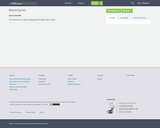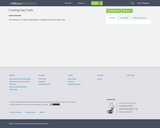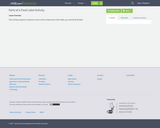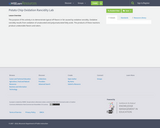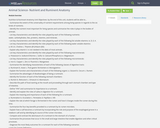
Nutrition & Ruminant Anatomy Unit Objectives: by the end of this unit, students will be able to…- Summarize the extent of the universality of nutrient requirements among living species in regards to the sixkinds of nutrients.- Identify the nutrient most important for living species and summarize the roles it plays in the bodies ofanimals.- List key characteristics and identify the roles played by each of the following nutrients:water, carbohydrates, fats, proteins, vitamins, and minerals.- List key characteristics and identify the roles played by each of the following fat soluble vitamins: A, D, E, K.- List key characteristics and identify the roles played by each of the following water soluble vitamins:a. B12 b. Choline c. Thiamin (B1)/Niacin (B3)- Explain why vitamin C is not needed in the diets of most animals.- List key characteristics and identify the roles played by each of the following macrominerals:a. Potassium b. Sodium/Chlorine c. Sulfur d. Calcium/Phosphorus e. Magnesium- List key characteristics and identify the roles played by each of the following microminerals:a. Iron b. Copper c. Zinc d. Fluorine e. Manganese- Summarize the identifying characteristics of each of the following classes of digestive tracts:a. Ruminant b. Avian c. Post-gastric fermenters d. Monogastrics- Explain the function and characteristics of each of the following organs: a. Gizzard b. Cecum c. Rumen- Summarize the advantages of disadvantages of being a ruminant.- Identify the function of each of the following stomach chambers:a. Rumen b. Reticulum c. Omasum d. Abomasum.- Describe the path of food starting at the mouth and proceeding through each stomach chamber and typeof intestine.- Define “VFA” and summarize its importance to a ruminant.- Identify and explain the roles of saliva in digestion for a ruminant.- Explain the meaning and importance of each of the following for a ruminant:a. Rumination b. Eructation c. Peristalsis d. Papillae e. Villi- Explain the rate at which forage is fermented in the rumen and how it changes inside the rumen during thistime.- Summarize the four key benefits provided to a ruminant by its rumen microbes.- Explain how a calf becomes a ruminant by incorporating the role and purpose of the esophageal groove in anewborn calf and by identifying its source of the rumen microbes.- Compare and contrast the abomasum of a ruminant to the stomach of a human.- Summarize the processes that occur in the small and large intestine that enable digestion and other criticalprocesses.- Diagnose the most likely outcomes for a ruminant for each of the following scenarios:o Iron Or Copper Deficiencyo Manganese Deficiencyo Swollen Large Intestineo Inability To Perform Eructationo Absent Or Swollen Villio Swollen Papillae/Inability To Absorb VFAso Reduced Saliva Productiono Decrease In Rumen Microbe Populations
- Subject:
- Agriculture, Food and Natural Resources
- Material Type:
- Module
- Author:
- Jennifer Russell
- Date Added:
- 08/14/2018
